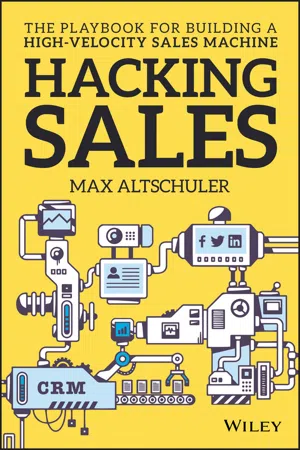
- English
- ePUB (mobile friendly)
- Available on iOS & Android
About This Book
Stay ahead of the sales evolution with a more efficient approach to everything
Hacking Sales helps you transform your sales process using the next generation of tools, tactics and strategies. Author Max Altschuler has dedicated his business to helping companies build modern, efficient, high tech sales processes that generate more revenue while using fewer resources. In this book, he shows you the most effective changes you can make, starting today, to evolve your sales and continually raise the bar. You'll walk through the entire sales process from start to finish, learning critical hacks every step of the way. Find and capture your lowest-hanging fruit at the top of the funnel, build massive lead lists using ICP and TAM, utilize multiple prospecting strategies, perfect your follow-ups, nurture leads, outsource where advantageous, and much more. Build, refine, and enhance your pipeline over time, close deals faster, and use the right tools for the job—this book is your roadmap to fast and efficient revenue growth.
Without a reliable process, you're disjointed, disorganized, and ultimately, underperforming. Whether you're building a sales process from scratch or looking to become your company's rock star, this book shows you how to make it happen.
- Identify your Ideal Customer and your Total Addressable Market
- Build massive lead lists and properly target your campaigns
- Learn effective hacks for messaging and social media outreach
- Overcome customer objections before they happen
The economy is evolving, the customer is evolving, and sales itself is evolving. Forty percent of the Fortune 500 from the year 2000 were absent from the Fortune 500 in the year 2015, precisely because they failed to evolve. Today's sales environment is very much a "keep up or get left behind" paradigm, but you need to do better to excel. Hacking Sales shows you how to get ahead of everyone else with focused effort and the most effective approach to modern sales.
Frequently asked questions
Chapter 1
Developing Your Sales Stack
Where Do I Start?

- Total number of deals in the pipeline
- Average deal size
- Percent of deals that move from stage to stage until they are closed
- Average time a deal stays in the pipeline
Qualifying Leads
- More leads at the top of the pipeline will result in better numbers at the bottom.
- Targeted leads at the top of the pipeline will provide better, faster results. These targeted leads are also known as your “low-hanging fruit.”
- “Seeds are word-of-mouth leads, usually from prior relationships or happy customers. These are how companies get started and where most of your first customers come from.
- “Pros: Highly profitable, word-of-mouth leads are the fastest to close and have the highest win rates. There's nothing better!
- “Cons: It's almost impossible to proactively grow them. You just have to do your best and be patient.
- “Nets are your marketing leads, such as internet marketing, events, webinars, white papers, advertising, and the like. You're casting a wide net, so this is about quantity over quality.
- “Pros: Easy to generate. Some kinds of marketing programs are scalable, you can generate leads from everlasting content, and they are highly measurable. There are ways to generate leads at almost no cost.
- “Cons: Not sure what will work, most leads aren't a fit, low conversion rates, mostly individuals/small businesses, small order sizes, a lot of cost and effort to build, optimize, and maintain.
- “Spears are when you have salespeople or business development people reaching out to specific targets, lists, or kinds of companies. It's a specific, targeted approach, driven by a human, with a goal of quality over quantity (the reverse of marketing Nets)…To be effective and scalable, you need a team of dedicated reps who only prospect—they don't close, manage accounts, or respond to inbound leads.
- “Pros: Very predictable results, enables a very targeted approach to ideal prospects at executive levels, fast is-it-working-or-not feedback cycle, creates a pool of sales talent.
- “Cons: Not profitable for small deals or customers, hard for old school companies to get the culture right (must avoid boiler room mentality), may be hard to get executive commitment to specialize and hire dedicated prospectors.”
What's Your Sales Stack?

Table of contents
- Cover
- Praise for Hacking Sales
- Title Page
- Copyright
- Author's Note
- Introduction
- Chapter 1: Developing Your Sales Stack
- Chapter 2: List Building: Part 1: Finding and Defining Your Ideal Customer Profile
- Chapter 3: List Building: Part 2: Defining Your Total Addressable Market (TAM)
- Chapter 4: List Building: Part 3: Getting in the Door
- Chapter 5: Uncovering Contact Information
- Chapter 6: Lead Research
- Chapter 7: Segmenting
- Chapter 8: Outbound E-Mailing and Messaging
- Chapter 9: Sales Outsourcing
- Chapter 10: Customer Relationship Management Software
- Chapter 11: Nurturing Leads and Sparking Engagement
- Chapter 12: Preparing for and Holding Your First Sales Call
- Chapter 13: Navigating the Buying Process and Closing the Deal
- Chapter 14: Business Development
- Chapter 15: Bonus Sales Hacks
- Chapter 16: The Wrap-Up
- Resources and Programs
- Acknowledgments
- About the Author
- Index
- End User License Agreement